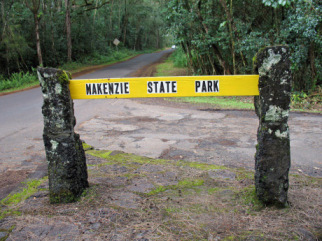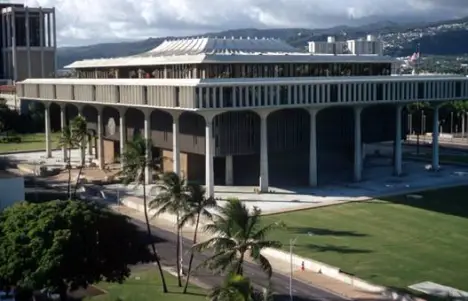The US Department of Agriculture’s prestigious Two Chiefs’ Award was presented today to M. Irene Sprecher of Hawaii’s Department of Land and Natural Resources.

Left to right is William Aila; Christine Clarke, Acting Director for the Natural Resources Conservation Service in the Pacific Islands Area; M. Irene Sprecher, award recipient; Diane Ley, Executive Director for the Farm Service Agency; and Randy Moore, Pacific Southwest Regional Forester from the US Forest Service. Photo by Jolene Lau, NRCS.
The Two Chiefs’ Award is a national award that is presented annually to recognize people and teams that work collaboratively to support conservation and forest stewardship. Award winners are selected by the Chiefs of the USDA Forest Service (USFS) and Natural Resources Conservation Service (NRCS).
Ms. Sprecher played a lead role in the development of the “Collaboration on Forestry Related Program Delivery in Hawaii” Memorandum of Understanding (MOU) between the USDA NRCS, the US Forest Service, the Hawaii Association of Conservation Districts and the State’s Department of Land and Natural Resources – signed May 19, 2011. This MOU was derived from the National MOU that is used for the same purpose and was signed September 29, 2008.
Since the implementation of the Hawaii MOU, the partners have significantly improved their communication and interaction with each other, and cooperated to coordinate the delivery of several Landowner Assistance Programs in Hawai’i (see http://dlnr.hawaii.gov/forestry/lap/ for more information).
Through this MOU, a landowner who obtains an approved Forest Stewardship Program management plan may access multiple programs for forestry conservation assistance – Forest Stewardship Program, the Conservation Reserve Enhancement Program (CREP) and/or the NRCS Environmental Quality Incentive Program (EQIP). This has significantly streamlined the process for landowners to access assistance funding, while simultaneously improved the collaboration among agencies and efficiency of their programs.
While this MOU is in place at the national level, not all states have implemented a state-level process, and most of those that have received some financial support to make it happen. Hawai’i has accomplished all of this with no extra funding provided by or given to any of its MOU partners. The MOU partners are involving existing staff only and are motivated simply to improve all aspects of private landowner assistance in Hawaii through increased cooperation.
Also, through a grant written by Ms. Sprecher, the Hawaii MOU partners were awarded $250,000 in January 2013 from a National Fish and Wildlife Foundation grant. These funds will provide needed resources for statewide planning and outreach to private forest landowners. Two full time staff were hired in August, 2013, to increase the number of CREP projects, complete more NRCS Conservation Plans, strengthen interactions with partner agencies, and generally support sustainable management of Hawaii’s forest resources.
Finally, Ms. Sprecher was instrumental in the Fiscal Year 2007 and 2008 Kealakekua Heritage Ranch Forest Legacy applications for the acquisition of two conservation easements. She was also the primary author for the Fiscal Year 2010 Kainalu Ranch and the Fiscal Year 2012 Kukaiau Koa Forest applications to the Forest Legacy Program. She was recently promoted, as well, and now runs the FSP and FLP programs in Hawaii.
Ms. Sprecher was a major contributor towards the establishment of the Conservation Reserve Enhancement Program (see factsheet, attached) in Hawaii. That process required extensive collaboration and negotiation with national and local partners in order to customize the program to best serve Hawaii, and to obtain all the required approvals. In addition, she has been very cooperative in modifying the Hawaii Forest Stewardship Program (supported via State and USFS funding) to come into alignment with the conservation practices, technical specifications and cost share rates associated with NRCS’s EQIP. Similarly to the Forest Stewardship Program’s management plans, this has made various Federal and State forestry conservation assistance programs work in parallel, with a consistent look and process for our prospective cooperators.
“We are very pleased to jointly present this award,” said Randy Moore, U.S. Forest Service Pacific Southwest Regional Forester. “This really illustrates our all-lands approach in working across boundaries to optimize our efforts. This hard work which continues today is vital to the health of our island’s forests in Hawaii and beyond.”
“I am so happy to recognize her and this multi-agency public-private approach to solving a critical resource problem on our forest lands,” said NRCS Acting Director Christine Clarke. “This work exemplifies good stewardship.”
“Ms. Sprecher has proven to be an extremely valuable partner for the USDA as part of our Hawaii Joint Forestry MOU. She worked very closely with NRCS to get forestry conservation projects on the ground and information out to potential clients. She’s collaborated with Ms. Katie Friday, of USFS, to get funding out for Forest Stewardship Plans. She is very worthy of this award for her contributions to USFS and NRCS here in Hawaii,” Clarke said.
Filed under: Agriculture, aloha, Announcements, Hawaii, National Affairs, State Affairs | Tagged: DLNR, M. Irene Sprecher, USDA | Leave a comment »







































